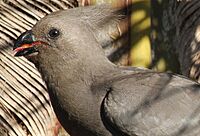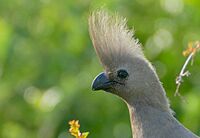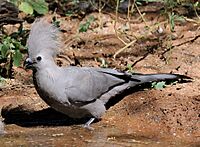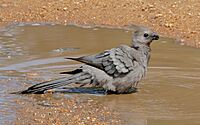Grey go-away-bird facts for kids
The grey go-away-bird (Crinifer concolor), also known as the grey lourie or kwêvoël, is a common bird found in southern Africa. These birds live in open woodlands, from dry to moist areas, especially where there is water and acacia trees. They often live in groups and look for food in the tops of trees. They also enjoy taking dust baths on the ground. When they are disturbed, they make loud, nasal calls that sound like "kweh" or "go-way." The last part of their call usually goes down in pitch. Their unique look and habits make them easy to spot and tell apart from other birds in their home range.
Quick facts for kids Grey go-away bird |
|
|---|---|
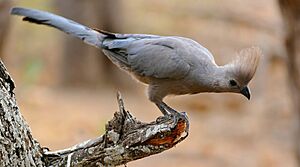 |
|
| Conservation status | |
| Scientific classification | |
| Genus: |
Crinifer
|
| Species: |
concolor
|
Contents
About the Grey Go-away-Bird
The grey go-away-bird was first officially described in 1833. This was done by a Scottish zoologist named Andrew Smith. He found specimens of the bird near what is now Durban, South Africa.
Smith gave the bird its first scientific name, Corythaix concolor. The word concolor is Latin, meaning "all one color" or "plain." Today, this bird is placed in the group of birds called Crinifer. This group was first named by a Polish zoologist, Feliks Paweł Jarocki, in 1821.
There are four main types, or subspecies, of the grey go-away-bird:
- C. c. molybdophanes: Found from northeast Angola to north Mozambique.
- C. c. pallidiceps: Lives from west Angola to central Namibia.
- C. c. bechuanae: Found from south Angola to north South Africa.
- C. c. concolor: Lives from south Malawi to east South Africa.
What They Look Like
Male and female grey go-away-birds look very similar. They are about 47 to 51 centimeters (18 to 20 inches) long from their beak to the tip of their tail. They usually weigh between 200 and 300 grams (7 to 10 ounces).
These birds have smoky-grey feathers all over their body. They have long tails and a wispy crest of feathers on their head. This crest is about 6 to 7 centimeters long and sweeps backwards. When the bird gets excited, it can raise its crest almost straight up.
Their strong, curved beak is black. Inside their mouth, the gape (the corner of the mouth) and tongue are a bright pink color. The feathers on their chin and throat are the darkest grey. The feathers around their eyes and on their belly are the lightest grey. Their chest feathers have a slight olive tint, similar to their close relative, the bare-faced go-away-bird.
Where They Live and Their Home
The grey go-away-bird is native to many countries in southern Africa. These include southern Angola, southern DRC, Zambia, southern Tanzania, Malawi, Mozambique, Namibia, Botswana, Zimbabwe, South Africa, and Eswatini.
They live in open savanna woodlands, whether they are dry or moist. They especially like areas where Acacia trees grow. You can often find them at the edges of miombo woodlands. They also live along rivers, in dry forests near rivers, and in acacia woodlands on floodplains. It's common to see them on farms and in gardens and parks in towns.
These birds need water to survive. They will travel along rivers in dry areas when water is flowing. They avoid places that don't have enough fruit trees. They also seem to leave areas where too many woody plants grow. Grey go-away-birds do not migrate regularly. Instead, they wander around looking for food and water.
How They Behave
Even though their flight looks slow and takes a lot of effort, grey go-away-birds can fly long distances. Once they are in the open tops of trees, they are very agile. They can run along tree branches and jump from one branch to another easily.
They often form groups that can have 20 to 30 birds. These groups move around together, searching for fruit and insects near the tops of trees.
What They Eat
The main food for the grey go-away-bird is fruit. They also eat flowers, buds, leaves, termites, and snails.
They get fruit from many different plants, including wild figs and berries. They also eat fruit from non-native plants like the seringa tree. When they eat these fruits, they help spread the seeds to new places.
Reproduction and Life Cycle
The nest of a grey go-away-bird is a flimsy platform made of thin, often thorny sticks. It looks a lot like a large dove's nest. Their almost round, white eggs can sometimes be seen from below.
Usually, the female lays three eggs in a nest. The nest is often placed in the center of a tree that stands alone. Both parents share all the duties of raising their young. The chicks are covered in thick brownish down feathers. They start to climb around the nest even before they can fly. The parents feed the chicks by bringing them regurgitated (partly digested) food.
The breeding season for these birds varies depending on the region. For example, it's from July to August in Angola, and all months in Zimbabwe and South Africa.



